 Leading Blog | Posts by Month |
 Leading Blog | Posts by Month |
02.28.11

LeadershipNow 140: February 2011 Compilation
Posted by Michael McKinney at 12:01 AM
02.23.11

Socrates on Communication
BETTANY HUGHES, author of The Hemlock Cup—a fascinating portrait of Socrates and Athenian society—says that “He reminds us to keep debating the meaning of life, to keep questioning, to keep speaking to one another, to keep looking for answers. However you value him, you cannot argue with the central tenet of his philosophy. Because he beseeches mankind not to be thoughtless.”  Socrates was wary of the written word. His anxiety was that it could neither account for itself nor answer back. Words were everywhere in Athena’s city, but Socrates, unusually, did not set his own down on papyrus with an inky flourish. In a city filled with authors of every kind, he was anxious about the impact of writing without the accountability of face-to-face contact. “I cannot help feeling, Phaedrus, that writing is unfortunately like painting; for the creations of the painter have the attitude of life, and yet if you ask them a question, they preserve a solemn silence.” Socrates was living through his own information revolution. He shares with us the same concerns. 
Posted by Michael McKinney at 11:12 PM
02.22.11

Leading As One: Generating Collective BehaviorTo be successful in the world we’re entering, we will need a new set of mental models. While these new models should not exclude the possibility of commanding and controlling, they need to encompass a much wider range of possibilities.The challenge facing any leader is turning individual action into collective power. In short, getting people to act as one. As One by Mehrdad Baghai and James Quigley, is the result of a two year research project conducted by Deloitte Touche Tohmatsu Limited, to understand this common leadership challenge and to answer the question, “What leads to effective collaborations in a wide range of fields?” Not just working together, but working as one. As we talk about leadership it is easy to confuse ends and means and seek collaboration for collaborations sake. The authors note that collaboration "is a means to an end, not an end in itself, and that because the purposes might be different you might need different styles" of collaboration for different situations. Thus we find successful leadership comes in many different shapes and sizes. They believe real leadership is about productivity, people and purpose—or As One Leadership—“leadership that results in a cohesive group of people working together effectively toward a common goal or purpose.” Initially the task is identifying which people need to be involved (the Who) and what purpose they need to satisfy (the What) and then How do we need to collaborate to get the results we seek. 
What emerged from the As One Flagship Project was the identification of eight models or archetypes of As One behavior. Arranged around two axes: a vertical axis that describes how power is exercised in an organization from emergent to directive and a horizontal axis that conveys the nature of individual’s tasks and outlines how work is organized from highly scripted and uniform to highly creative. 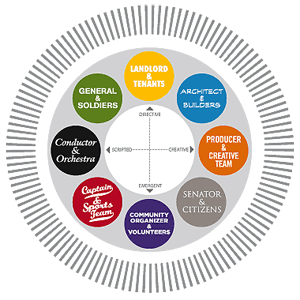 Not surprisingly, these archetypes reflect both top-down and bottom-up styles. The analysis is very balanced. In the descriptions that follow, you can see that different kinds of organizations or situations with different kinds of objectives call for different kinds of leadership. It is enlightening to identify your type of organization and the related leadership approach. The book presents case studies of each type, an explanation of the key characteristics, and a discussion of what you can do to be better at that type. Not surprisingly, these archetypes reflect both top-down and bottom-up styles. The analysis is very balanced. In the descriptions that follow, you can see that different kinds of organizations or situations with different kinds of objectives call for different kinds of leadership. It is enlightening to identify your type of organization and the related leadership approach. The book presents case studies of each type, an explanation of the key characteristics, and a discussion of what you can do to be better at that type.
The Deloitte Center for Collective Leadership was launched in January to advance the study of the As One Collective Leadership discipline and As One behavior. Through research, data collection, and analysis, this center will help define and increase knowledge in the exciting and dynamic field of collective leadership. If you are wondering what your model is, they have created an online As One Classifier tool to figure out which archetype is closest to your current situation. THE EIGHT ARCHETYPES The four main archetypes are: Landlord & Tenants: The Landlord & Tenants pairing is based on landlords’ top-down driven strategy and power: they control access to highly valuable or scarce resources. Landlords decide how to generate the most value for themselves and dictate the terms of participation for the tenants. Tenants voluntarily decide to join landlords, and it’s usually in their best interests to do so. However, once they do, landlords define the rules of participation. Landlords maintain their power by ensuring the best tenants are rewarded, so that, over time, as the number of tenants grows, the landlords’ power increases. Community Organizer & Volunteers: The Community Organizer & Volunteers pairing is based on volunteers’ bottom-up, autonomous, independent, decision-making ability and their desire to voice their opinions. Community Organizers ignite volunteers’ interest through compelling storytelling and opportunities for volunteers to join in. They may have little direct power over the volunteers, but they can tap into volunteers’ interests by gaining their trust, promoting a strong brand, and understanding their motivations. Volunteers themselves are drawn together by a rallying cry, or out of a sense of enlightened self-interest; they gain their power through a strength-in-numbers approach. Conductor & Orchestra: The Conductor & Orchestra pairing is based on highly scripted and clearly defined roles that focus on precision and efficiency in execution as defined by the conductor. The orchestra members, who have similar backgrounds, need to be fully trained to comply with the requirements of the job, and, therefore, must be carefully selected to ensure they fit the strict culture and scripted tasks. Belonging to the orchestra provides members with the best way to make a living while focusing on tasks at which they excel. Producer & Creative Team: The Producer & Creative Team pairing is typically about producers providing their creative team with the freedom to do their best work and reach their natural potential. This pairing is led by legendary, charismatic producers who bring together a team of highly inventive and skilled independent individuals to achieve the producers’ objective. Producers guide the vision and overall progress, while the creative team develops ideas through frequent meetings and interactions using an open culture of collaboration. Dissent is used to push creative boundaries. To maintain longevity in their industry, producers and creative teams need to continuously produce new and innovative ideas. The four hybrid archetypes combine the characteristics of the adjacent pairings and occupy the spaces between the axes. General & Soldiers: The General & Soldiers pairing has a command-and-control-type culture combined with a multi-level hierarchy organized around the general’s clear and compelling mission. Soldiers’ activities focus on clearly defined and scripted tasks. They are motivated by advancing up the hierarchy through well-defined roles at all levels. Soldiers undergo extensive training to understand the army and its culture, and to learn specific skills. They are committed to the mission, the overall institution, and each other, while the general provides strong top-down authoritarian direction to motivate and direct them. Architect & Builders: The Architect & Builders pairing focuses on the creative collaboration between groups of diverse builders that have been recruited by visionary architects to bring a seemingly impossible dream to life. Their visions are so innovative and ambitious that they can’t be achieved simply by using conventional means, so builders often need to reinvent and rethink ways to achieve them. Builders strive to meet ambitious deadlines and milestones mapped to deliberate workcycles. As each milestone is completed, the builders become one step closer to bringing the architect’s dream to reality. The Architect & Builders hero story is based on the development of the world’s cheapest car, the Tata Nano. Captain & Sports Team: The Captain & Sports Team pairing operates with minimal hierarchy and acts like a single cohesive and dynamic organism, adapting to new strategies and challenges with great agility as they appear. Members of the sports team have a strong shared identity. They have extensive and networked communication channels, and carry out the same highly scripted, repeatable tasks. There is strong camaraderie and trust among the sports team – the collective good outweighs the needs of the individual – while captains are there, on the field as part of the team, to motivate and encourage. Senator & Citizens: The Senator & Citizens pairing is based on a strong sense of responsibility to abide by the values or constitution of the community, which have been outlined by the senators. Sovereignty is held by both senators and citizens, and the citizens thrive on the values of democracy, freedom of expression, and autonomy. Since citizens are autonomous, the community structure is flexible. There is no set framework or direction organizing the citizens. Instead, much of their direction is emergent as they gather ideas and collaborate with other citizens. Senators are the guiding intelligence for the citizens and oversee decision making for the community. There is no one size fits all archetype and each archetype is more nuanced than described. Putting As One into practice consists of three steps: First, a diagnostic to assess the who and to do what and then determine the how or what archetype is being used. Second, determine the type of intervention to strengthen the archetype being used or to create a new approach and third to adopt the approach across the organization and applying different archetypes in different situations even in the same organization. It is an interesting study that begins to create a broader understanding of what it takes to lead at all levels as opposed to the common polarizing either/or discussions of command and control versus collaborative leadership. It also helps to dispel the myth that top-down leadership is synonymous with command and control. 
Posted by Michael McKinney at 12:11 AM
02.18.11

Making the Transition From Bud to Boss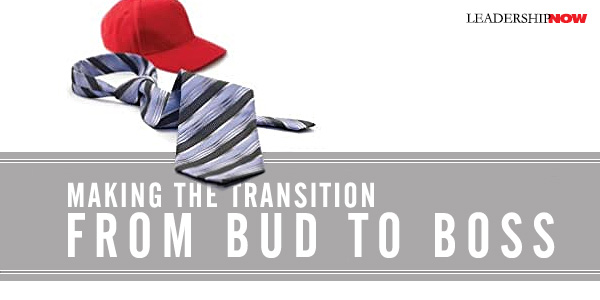
OFTEN, when we are given a formal leadership role a couple of questions come to mind: Will they take me seriously? and How can I develop the influence I need to do this job? A promotion changes the scope of the kinds of things we have to think about. It changes the degree to which we have to regulate our behaviors, conversation and opinions. In short, it changes our relationship with everyone around us. How will we handle it? What about old friendships? They’re all watching us. It can make us feel a little anxious and insecure. From Bud to Boss is written for that moment. It is designed to get you pointed in the right direction and engaging in productive behaviors and thinking. Authors Kevin Eikenberry and Guy Harris have organized this book around six key areas of concern:
What they offer isn’t counterintuitive, they’re just things that we forget to do or find difficult to do and so we don’t. But ignoring them affects our ability to lead. This is an action-oriented book and is extensively supported by the Bud to Boss community on the Internet. To help you get your foundation for leadership in balance, Eikenberry and Harris discuss the impact of your leadership style: In your leadership style, you probably have a natural “lean” that is a little more toward getting things done or toward people and relationships. One major key to leadership success lies in learning to compensate for the way you learn so that you stay balanced between getting things done and building relationships. This is a key point. You need to become more self-aware. You will be judged for results, but if you try to get those results without maintaining the respect of those around you, you will ultimately fail as a leader. So often when we get into a position of authority we begin to think, “How can I get these people to do what I want?” The question seems innocuous enough, but the danger is that it can lead us to focus on controlling others and forget that the task of leadership is to influence others. The authors suggest turning the focus of the question around: “How do I change my words and behaviors so that I communicate with my team more effectively?” or This kind of thinking places responsibility where it should rightfully be. You. They write, “Control what you can. Influence who you can.” From Bud to Boss provides direction and tools that will allow you to take the right action and build confidence—the essential forward momentum you need to be successful. It should go without saying, but it is said, so I’ll mention it. No book, speech, or coach will ever be able to cover everything you could need to know. Because the players are all different, it isn’t possible to address everything specifically. So the trick for us is to get the general principles down and learn to apply them. That’s really what good books, speakers, and coaches try to do; give you principles and tools that you can learn to apply properly in the situations you face as they come up. That’s what From Bud to Boss does well. The rest is up to you. 
Posted by Michael McKinney at 08:35 AM
02.16.11

Frances Hesselbein: To Serve is To Live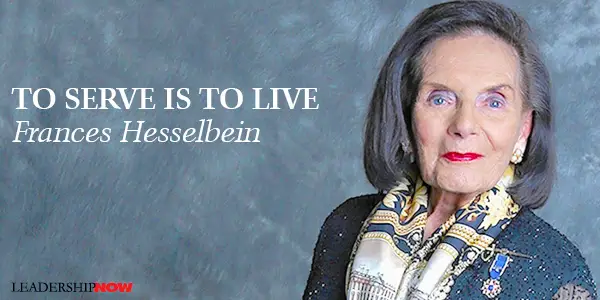
FRANCES HESSELBEIN is a remarkable leader because she doesn’t try to get others to think of her as a leader, she tries to get others to think of themselves as leaders. Reading her autobiography, My Life in Leadership, I was struck by the importance she places on inclusion, respect, civility, decency, honor, honesty and faithfulness. It’s not surprising then, that she never thought of herself as a “woman leader,” but always as “a leader who is a woman.” Hesselbein didn’t start out to be a leader, but she became one by expressing her best self in all that she did. An example for all would-be leaders to follow. Her mantra is, “to serve is to live.” Her father was her hero and when he died, she dropped out of college to help support her family. Later she married and raised a family with no intention of leaving her hometown in Pennsylvania. Later to help out, she volunteered to serve as a Girl Scout Troop leader. Eventually, as doors opened for both her and her husband, she was asked to head the Girl Scouts of the USA which she did from 1976 to 1990. From her contribution there, she was named “Best Nonprofit Manager in America” by Fortune Magazine. In 1998 she was awarded the Presidential Medal of Freedom in recognition of her exemplary leadership as CEO of Girl Scouts of the USA, her role as the founding president of the Drucker Foundation, and her service as “a pioneer for women volunteerism, diversity, and opportunity.” My Life in Leadership is full of lessons. Here are just five of the lessons she has learned along the way. I’m certain you’ll find at least one that will improve your leadership approach and thinking. “If we value diversity and inclusion, then we must ask, ‘When they look at us, can they find themselves?’ This is the powerful question that uncovers whether an organization practices what it preaches.” At the Girl Scouts of the USA, she worked hard to make sure people of all races and backgrounds could find themselves in the organization. She writes: “One of the most important parts of transforming a large and complex organization is inclusion: engaging all of the people every step of the way... Inclusion is a powerful value: when we open up the organization, dispersing the leadership, including people from across the enterprise, there is a new energy, a new synergy.” At one point she asked her staff to introduce themselves to each other at a meeting. She shares the story of a staff member that understands what it means to think like a leader—be a leader—no matter where you find yourself in an organization: “My name is Troy. I work in the mail room, and I like to think of myself as the heart of the organization. Everything that comes into the organization comes through me. Everything that goes out of the organization goes through me. I am the heart of the organization!” She adds, “Troy’s ‘heart’ brought to us new insight about the importance of every person and every position. I’ve never forgotten Troy and that moment.” When making a decision about change you can’t stall in indecision but you can’t run over people either. She explains how she handled a touchy situation and then writes: “When does the sled take off? Is the question for all leaders, knowing that we can fail if the sled leaves too early with too few people on it, or we can wait too long, and someone else will have filled the need and eaten our lunch…. It takes managerial courage to decide that it is time for the sled to take off when many are hesitant to climb on board. A leader respects their opinions and their positions, but cannot be deterred by them. Later these people may change their minds and join you, but if you act in a dismissive way that diminishes them, they never come back. Save the face and the dignity of the people who oppose the initiative. That is a key principle in managing change and mobilizing people around that change.” In 1981, at a GSA meeting, Peter Drucker told them: “You do not see yourself life size. You do not appreciate the significance of the work you do, for we live in a society that pretends to care about its children, and it does not.” Hesselbein said, “I wanted to refute this, but could think of nothing to say. Drucker continued, “And for a little while, you give a girl a chance to be a girl in a society that forces her to grow up all too soon.” Hesselbein adds, “We took him seriously.” How many of us see what we do “life size?” Hesselbein says the number one element of listening is “banish the but.” She writes: If we want people to listen, we must banish “but” from our vocabulary. How many times have we had someone tell us how well we performed—and we were feeling good about the feedback, listening carefully—then we heard “but,” and the positive, energizing part of the feedback was lost in the “but” and what followed it. “But” is nobody’s friend—listener or speaker. “And” provides the graceful transition, the non-threatening bridge to mutual appreciation, the communication that builds effective relationships. Hesselbein believes that “in the end, it’s the quality and character of the leader that determines the performance.” As President and CEO of the Peter Drucker Foundation for Nonprofit Management (now the Leader to Leader Institute), she was asked what the two most powerful messages were that he left with her. She said, “Think first, speak last” and, “the leader of the future asks; the leader of the past tells. Ask, don’t tell.” In the foreword, Jim Collins sums up well the example of Frances Hesselbein: No matter what knocks you down, you get up and go forward. You might be appalled by horrifying events, but never discouraged. You might need to deal with mean-spirited and petty people along the way but never lose your own gracious manner. You might need to confront a litany of brutal facts and destabilizing uncertainties, but it is your responsibility, as a leader to always shine a light.  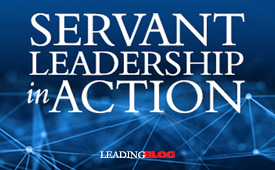 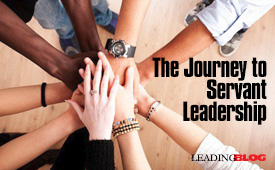
Posted by Michael McKinney at 06:00 PM
02.14.11

The Wisdom of Booker T. Washington  Washington was born into slavery to a slave mother and a white plantation owner in Franklin County, Virginia. He became a national figure with his Atlanta Address of 1895, in which he advocated vocational education for blacks as a way to improve race relations, making him a popular spokesperson for African-American citizens. Through the support of wealthy philanthropists, he was able to raise funds to establish and operate thousands of small community schools and institutions of higher education for the betterment of blacks throughout the South. In 1901, his popular autobiography, Up From Slavery, was first published and has been translated into many languages. On Leadership
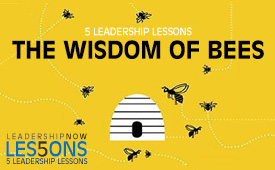 
Posted by Michael McKinney at 12:44 AM
02.11.11

Taking Another Look: Leading Minds on Reflection Part 4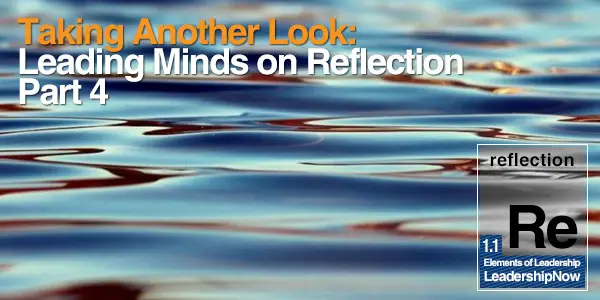
In the final part of this series, Marshall Goldsmith explains the relevancy of reflection in today’s world. It has always been a vital ingredient to success, but it becomes critical in the age of the knowledge worker. Jeremy Hunter teaches courses on The Practice of Self-Management at The Peter F. Drucker and Masatoshi Ito Graduate School of Management. He emphasizes a focus on reflecting in real-time—in the present—in order to align both our intentions and behaviors so that we might bring about the results we seek.
I believe that the process of reflection is more important today than ever before. I also believe that it is more challenging. We live in the age of the knowledge worker. Peter Drucker defined knowledge workers as 'people who know more about what they are doing than their boss'. Knowledge workers need to think and reflect. They have to listen and learn. They cannot just 'do what they are told', since their managers know less than they do about what they are doing. On the other hand, we live in a world of constant stimulus. Our minds are barraged by media of all forms. Cell phones, emails, text messages, and personal computers have reduced our already-limited attention spans. One of the great challenges for the knowledge worker of the future is finding the time to think - in a world that is screaming at you to act.
When we think of “reflection” it tends to be retrospective. Where I think my work is a bit different is that I focus on what a leader is doing right now as it is happening––reflection and awareness in the moment. Most people's immediate action will very likely be an automatic non-conscious process that they're not aware of. Throw in a little stress and emotional reactivity and people find themselves doing and saying things that are destructive to themselves, others, and their goals without understanding why nor knowing what to do about it. The big issue is that the retrospective analysis alone can’t necessarily change a person's immediate habits. Science tells us that 90% or more of the brain’s activity is automatic and non-conscious. However, we have a worldview that focuses largely on conscious processing, we think that having the answer makes change automatically happen. A friend might say, “You know, Ruth, when you’re confronted with a challenge from a superior, you react too strongly.” OK, now Ruth knows that. We assume that just because Ruth knows what she does, she will change it. But there’s a whole other process that has to happen to change the wired-in, non-conscious, automatic pattern. Ruth may be 100% aware of what she does but then the trigger happens and it plays out in the same way. And then it’s, “Oh no, I did it again.” Change happens in the choices we make right now. So my interest is in, how you actually retrain the brain by interrupting that automatic habit and doing something differently. You may have to do it over and over again but at some point, the rewiring function will happen. And that’s a function of interrupting that immediate non-conscious habit and doing something different. I give people a model of this process from the triggering moment of contact to the final result. All along there are intervention points. Of course, the earlier you can intervene, the better. Not everyone can interrupt the process early on, but what I emphasize is that you just need to interrupt it somewhere. And the more practiced one gets at it, the earlier you can see what is happening. It’s really about becoming more conscious about what you are doing, why you are doing it, what result do you want and do these behaviors get you there, and if they don’t, what do you need to be doing instead? You always start with the repeated unwanted result. What’s the thing that keeps happening that you don’t want? For example, Ruth might say, “I notice that whenever I’m confronted, I fight back too aggressively or I get too hostile.” So now she knows that about herself and that’s the reflective piece. Now, let’s tie that reflection to action. The next step is to build awareness of when and how that habit plays out. For example, “I have this meeting with my boss and I know he’s upset about something. What is it I do that might push back too hard, that gets me in trouble?" And so in that moment, she's bringing attention to all the things that happen automatically--what is she doing? What is she feeling in the body? Tension? Pressure? What emotions are arising? What are the stories in her head? Directing her attention to her internal experience creates the awareness of the non-conscious habit. She now has the opportunity to step outside all those automatic reactions and make a different, more conscious choice. We’re tying the process of reflection to immediate behavior. Again, change happens in the choices we make right now. As people are increasingly “burned out” from the stress and uncertainty of the economic reset, it’s too simplistic to just return to basic vacation policies, doing little to introduce meaningful distinctions between home and work. When the workday rarely ends, given technology’s ability to engage employees any time and anywhere, sabbaticals offer a refreshing moment to simply pause. Sabbaticals lead to people stepping back to see their work and creativity through a different lens. —Daniel Patrick Forrester, Consider
More in this Series:
Posted by Michael McKinney at 11:14 AM
02.10.11

Taking Another Look: Leading Minds on Reflection Part 3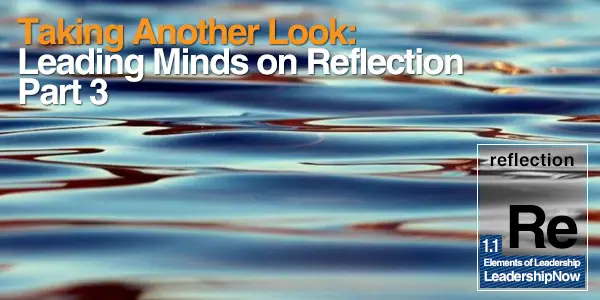
In part three of this series, James Strock talks about the importance of taking time “off” from one’s customary activities. He also gives insight into gaining perspective through reflection. Mark Sanborn talks about the essential nature of making time to think so that we might learn and gain insight from our experiences. He lists some areas we should be thinking about so that we might get the most out of our time reflecting.
There is nothing more important—or more easily overlooked—than making time for disciplined reflection. Indeed, it should be scheduled—and protected and enforced—with the utmost seriousness. Religious traditions include notions of a Sabbath, a day of rest and reflection. It’s a recognition that taking time “off” from one’s customary activities is necessary to fulfill one’s obligations, to perform effectively over time. It’s also an act of humility, pulling people away from a prideful presumption of the significance of their personal contribution and control when it tends toward isolating, habitual overwork. It’s surely not a coincidence that so many of the greatest leaders have been noted for multiple interests. Winston Churchill was active as a painter, speaker, historian, and commentator on current events. Theodore Roosevelt was, in the memorable description of Brander Matthews, “polygonal.” George Washington and Abraham Lincoln maintained perspective through theatre. Though it would be an error to say that effective leaders have “balanced” lives at any given moment, they tend to bring a number of interests to bear—thereby increasing their capacity to see things from various perspectives and to discern and appreciate the contributions of others. In business, one thinks of Bill Gates’ semi-annual, week-long sabbaticals for study and reflection. Many enterprises—from Google and GE to sports teams—encourage regular meditation or related mental exercises. To the extent each day can be seen as a sort of lifetime in itself, meditation or prayer can also be viewed as a sabbatical of sorts. In my personal experience, travel can be invaluable. Simply being pulled out of one’s daily routines and habits, and being inspired by new surroundings, can be mentally and spiritually invigorating. You may see familiar notions with new eyes. Though disciplined reflection has always been important for leadership, it’s arguably more important now than ever before. In the 21st century, information and data are often ubiquitous. The value added by leaders—either in high positions or not—increasingly arises from those invaluable intangibles: judgment and insight. Both of those are more likely to be found with disciplined reflection. And there’s no better place to start than from history and the observations and experiences of others, such as is offered so notably by LeadershipNow.
Someone once said if we don't slow down occasionally nothing good can ever catch us. I think that sentiment applies to the good that can come out of reflection. One of the reasons we don't learn—truly internalize lessons—and keep making similar mistakes is that we don't pause long enough to gain any insights. Most of the busy and successful professionals I work with—and myself included—can go for long periods of time without actively thinking. We reactively think—response to questions, problems, opportunities, etc.—but don't make time to proactively think. I frequently say that nobody has time for anything; we make time for what is important. So often we live life by default and let circumstance and the demands of others determine how we spend our time. I believe we need to make time for reflection. We make time when we priorities, eliminate and adjust our schedules. Specifically, I think leaders should reflect on:
Reflection usually requires "getting away" whether that requires a physical relocation to a peaceful thinking spot or simply blocking time to avoid interruptions.
There is a hierarchy of communication we all practice, in which electronic and immediate data responses reign far above in-person and more time-intensive, dialogue-driven interaction. The trade-off is easy to make: we gain speed, immediate connection, and reactions while giving up richer contexts that emerge only when we take time to think. There are times when the arrival of each new electronic message or data-driven distraction has become a digital proxy for the sound of a bell once used by a doctor named Pavlov. —Daniel Patrick Forrester, Consider
More in this Series:
Posted by Michael McKinney at 10:58 AM
02.09.11

Taking Another Look: Leading Minds on Reflection Part 2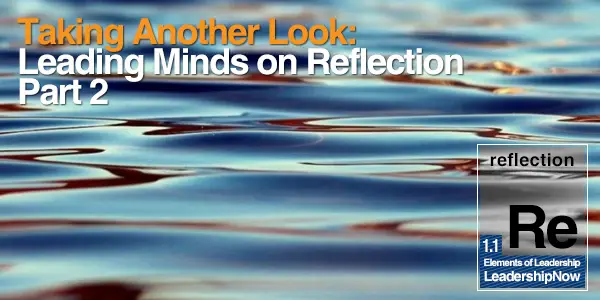
In part two of this series, Tom Asacker philosophizes about the nature of reflection. His insights help us to understand that until we start to see our connection to reality, core changes rarely happen. Have we given the proper consideration to the impact of what we do? Then, Brian Orchard emphasizes the need to slow down enough to absorb what we are experiencing. He talks about the need to take a second look to gain understanding and the importance of getting counsel in decision making.
I’ve noticed something interesting of late. I’ve been spending more time reflecting on my work than passionately involved in the doing of it. To an outsider, it may look like idleness. In fact, history informs me that it’s a necessary prelude to meaningful change, to boldness and growth. Our work should be designed to move us forward, toward a worthy ideal, meaning, and a better life. But in order to get there, we must occasionally pause from its narcotic effect and critically evaluate its impact on our happiness and well-being, and its resulting influence on our community and environment. We must sit quietly and reflect. Reflection is not daydreaming. Reflection is imaginative inquiry; it’s an internal dialogue that asks, Am I making a difference? Is this the best that I can do? Will people be advanced by my efforts? Will my children be proud of my actions? Yes, there is boldness in action. But we must follow action with quiet reflection for that boldness to remain relevant and vibrant. Elbert Hubbard wrote, “The reason men oppose progress is not that they hate progress, but that they love inertia.” Reflection is the path to progress. Imaginative reflection breaks the powerful grasp of inertia—the desire to stay the course regardless of the impact on our lives—and moves us courageously towards our higher potential.
This quote from the Guardian summarizes for me, where we are at: “Although, because of the Internet, we have become very good at collecting a wide range of factual tidbits, we are also gradually forgetting how to sit back, contemplate, and relate all these facts to each other.” And so, as Carr writes, "we're losing our ability to strike a balance between those two very different states of mind. Mentally, we're in perpetual locomotion." From my experience as a minister, I have found that an issue is rarely understood well by the first exposure to it. Our first response is usually weighted by whoever presented the issue. It takes time and thought to slowly come to a more complete understanding. The value of reflection in this case allows for a deeper understanding to be obtained by thinking about the issue and allowing it to be seen from a number of angles. There are two biblical principles that to me, support reflection. First, Proverbs 18:17 states, “The one who states his case first seems right, until the other comes and examines him.” We all have the tendency to accept the first version of what we hear, but the concept of “searching” carries the idea of talking and asking questions, but also thinking about the situation and the reconsidering of fundamental assumptions. The second is simply the whole idea of seeking counsel. This must mean a certain amount of reflection and counsel has a strong bearing on decision making. Devaluing reflection while expecting constant growth and innovation is nonsensical. It’s only when we step away from the onslaught of the day that a new direction arises (good or bad). By never stepping away and, instead, insisting on constant connectivity, you can’t be sure if what you are working on will prove you to be relevant in the future. —Daniel Patrick Forrester, Consider
More in this Series:
Posted by Michael McKinney at 10:43 AM
02.08.11

Taking Another Look: Leading Minds on Reflection Part 1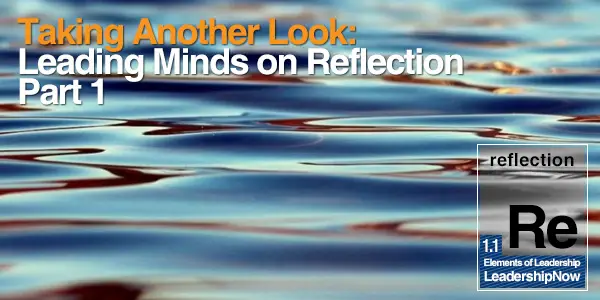
John Kotter begins this series on reflection by talking about the need to develop a reflective habit and why we don’t. Are we spending our time on the right issues? Are we delegating issues we should not be working on that could be better dealt with more locally in the organization? Kotter also stresses its importance as a continual learning tool. John Baldoni urges us to make the time to reflect to gain perspective. He reframes reflection as an action step, not a passive process.
In a world that is moving faster and faster, and changing more and in larger leaps, learning becomes a gigantic issue. Doing what you know is not enough. And learning cannot come in a classroom once every 2 years. That’s too little too late. Learning has to be an ongoing process, literally all the time. People learn in many ways. Reading really good books can help. Talking to really good people can help. Nothing wrong with going to a Harvard executive education program, but there is no better teacher than reflection on the world, and especially one’s own actions. I did X. It produced Z. But is Z what we really need? And why did X create Z? And what were the other alternatives? And can I find others (in books, discussions, HBS) that tried those other alternatives? Obviously, self awareness makes this easier. If I pay no attention to what I am really doing, what it is really producing, it’s hard to reflect on that. One can be both action oriented and reflective. Action oriented means when you know what to do and you do it. Now. Not next quarter. Let’s go. Reflection means using the time on airplanes, when you’re not on the slopes or with family at the ski lodge, Zenning-out on the beach—whatever—to think. People don’t reflect because they have no time, but usually because they don’t delegate enough, let others delegate up to them, or don’t have the staff they can delegate to—all correctable problems. People don’t reflect because they haven’t—so they have no reflective habit, so to speak. Correctable too. Since the end game is life, not one’s job, all this is not only applicable to life in general but is arguably more important for life in general. And since leaders have the capacity to help or hurt us all a great deal, everything I have said here is very important in their case.
Reflection is a powerful tool for leaders, and one that is much underused. The chief reason is perceived lack of time. I remember asking the late Skip LeFauvre, the man who ran Saturn, how he found time for it. He said, "Put it on your schedule." Reflection is a means of gaining perspective. It challenges you to think where you are now and where you might want to go. How to get there is a good thing to consider during reflection.
Constant change doesn’t lend itself to instantaneous insights through simple phrases like “too big to fail,” and “liquidity crisis.” The question we must ask ourselves is this: In the midst of dramatic and extreme change, has decision making devolved into merely informed chaos, or can we imbed reflection and think time into our habits and routines to arrive at better outcomes and understanding? —Daniel Patrick Forrester, Consider
More in this Series:
Posted by Michael McKinney at 01:47 PM
02.07.11

Consider: Harnessing the Power of Reflective Thinking in Your Organization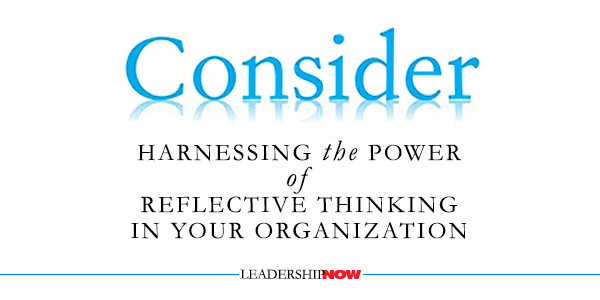
PETER SENGE, founder of the Society of Organizational Learning and senior lecturer at the MIT Sloan School of Management, once observed, “Most managers do not reflect carefully on their actions.” Most managers are too busy “running” to reflect. While reflection seems to have no place in a competitive business environment, it is where meaning is created, behaviors are regulated, values are refined, assumptions are challenged, intuition is accessed, and where we learn about who we are. Some of the greatest barriers to getting the results we want lie within us. Growth happens when we stop repeating our habitual patterns and behaviors and begin to see things in a new way and in the process, discover the power to create the results we want. That makes Consider: Harnessing the Power of Reflective Thinking in Your Organization, one of the most important books you’ll read this year. Author Daniel Patrick Forrester states, “Stepping away from the problem—and structuring time to think and reflect—just may prove the most powerful differentiator that allows your organization to remain relevant and survive…. The best decisions, insights, ideas, and outcomes result when we take sufficient time to think and reflect….Only by carving out think time and reflection can we actually understand, in an entirely different context, the actions we take.”He defines think time as “the purposeful elevation of chunks of our work time, forged within densely packed schedules. It forces the consideration of core significant and pending decisions, outside of cursory overviews and immediate response…. Reflection is the deliberate act of stepping back from daily habits and routines (without looming and immediate deadline pressures), either alone or within small and sequestered groups. It’s where meaning is derived through reconsideration of fundamental assumptions, the efficacy of past decisions and the consequences including the downside of future actions. It’s where space is given for the ‘totally unexpected’ to emerge.” Even if we can agree on the value of think time, we still regard it as a luxury. There’s just no time. But what emerges from Forrester’s research is the fact that we can’t afford not to. It is at the core of what allows a business to thrive. It’s what we don’t know that has a disproportionate impact on us personally and organizationally. We don’t really see the reality we face. Reflection in effect expands our perspectives and thus reveals to us more options and that gets to the heart of what leadership is all about. The point is to make the unseen seen so we can act on it. Forrester interviewed Sarah Sewall who worked with General Petraeus and others to rewrite the military’s counterinsurgency doctrine. Sewall noted, “We are now in a world of increasing specialization, where people get narrower and narrower in their viewpoints in order to become more expert and ‘useful.’ My view is that people become more myopic in how they can think about problems and solutions. We wind up shuttered in our ability to think about possibilities.” This tendency is best counteracted by think time and reflection; being able to back away and incorporate more and varied thinking. Forrester asks, “What is the last document or strategy you can point to as a ‘product of reflection’ built with all parts of the organization and senior-level involvement? If you can’t cite one, it may indicate a culture that values immediacy and the short term over reflection and scalable problem-solving.” Recognizing the need for reflection and actually doing it are two different things. Reflection is a discipline. General Petraeus told Forrester that “he forces bursts of reflection into his day, where he pauses to read, think, and then moves to the next iteration—recognizing that thoughtful insights are not born through real-time analysis.” Forrester suggests that we set time aside for a meeting with oneself. “It isn’t hard to book a meeting with yourself, when you are off-limits to everything but your thoughts.” He notes too, “The power of reflection lies not in how much time we allocate to it. The power of reflection lies in how we choose to use that time and what structure we bring to the fleeting disjointed moments we are afforded.” While some situations required his immediate action, Forrester describes how Lincoln “developed ways to force time to think (if even only for a few minutes) before acting. Even Lincoln had to resist the “instantaneous nature of the telegraph.” Some organizations he has studied have adopted a no internal e-mail Friday policy and other ways to temporarily disconnect from technology. Although these ideas may not work for you, the point is made so that you might consider the impact these technologies are having on the productivity and well-being of your staff. There is always one more e-mail and it will control you if you let it. “When overworked people declare that they ‘just don’t have time to think,’ leaders have a choice: They settle for the status quo and declare that it’s the best way the world works today, or they can insist that reflection is a strategic business enabler,” says Forrester. As an organization, you can either educate for it, make it an expectation—a cultural norm—or treat it as a “do it on your own time” activity and pay the price. Leaders need to understand and demonstrate by example that reflection—taking time to consider—is not wasted time. Reflection is the first step in coming to understand how we are connected to our outcomes. Until we see the relationship between the two, we cannot make deep, lasting change and bring thoughtful behaviors to bear on the situations we find ourselves in. Our thinking creates our reality. If we do not reflect on our thinking we stand to miss our connection to the whole. Consider offers a way to break the pattern of continuous partial attention that seems to be our default position in this technological age. It helps to disrupt the habitual thinking that drowns out the reflective, critical thinking we need to become fully present and effective. Consider isn’t a fad. It is the bedrock of successful leadership and living. Upcoming: I asked some leading minds about the discipline of reflection. So, for the rest of the week, I’ll share their thoughts on this important topic. Look for valuable insights from John Kotter, Mark Sanborn, Brian Orchard, Marshall Goldsmith, John Baldoni, Tom Asacker, James Strock, and Jeremy Hunter.  More in this Series:
Posted by Michael McKinney at 01:57 PM
02.06.11

Ronald Reagan on Leadership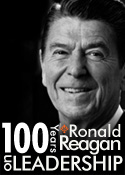 In her memoir, Personal History, the late Katharine Graham, former publisher of the Washington Post, tells a story about a dinner at her home attended by the Reagans and others in November 1988. When the Reagans arrived they were surrounded by well-wishing friends. Graham remembers that after someone knocked against a glass and spilled a drink, “I was dumbstruck,” she recalls, “at seeing the president of the United States down on his hands and knees in the middle of the crowd, picking up the ice.” Reagan possessed a servant quality that resonated with millions of people in America and abroad. On Vision:
Reagan believed that it is important for a leader to rise above secondary concerns to remain consistent and focused. His most important task was keeping his staff focused despite daily distractions. One of his aides recalled: "It was striking how often we on the staff would become highly agitated by the latest news bulletins. Reagan saw the same events as nothing more than a bump in the road; things would get better tomorrow. His horizons were just not the same as ours." James Strock sums it up well in his book, Reagan on Leadership: “As with all leaders of consequence, Reagan’s ability to lead others was an outgrowth of his ability to govern himself.” Of Related Interest:
Posted by Michael McKinney at 12:15 PM
02.04.11

The Power of Meeting People Where They Are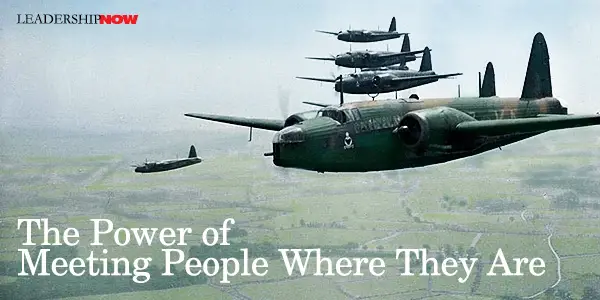
IN Split-Second Persuasion, Cambridge psychologist Kevin Dutton asks why some of us are better at the art of persuasion than others. He recounts a story about Winston Churchill’s encounter with war hero James Allen Ward that illustrates the power of meeting people where they are:

Posted by Michael McKinney at 10:12 AM
02.03.11

4 Building Blocks of Courage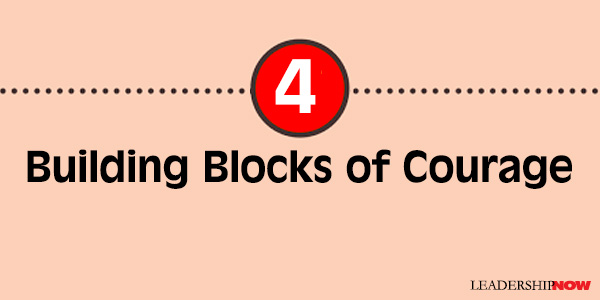
AS THE GLOBE begins to shake faster and faster, the answer is not to hunker down and erect barriers, but to take action. “Our world needs leaders capable of collaborating with other cultures sand taking prudent risks to create a new range of opportunities,” says Blythe McGarvie author of Shaking the Globe. That kind of leadership requires courage. McGarvie describes courage as “a firmness of mind and will in the face of danger or extreme difficulty.” A courageous leader understands “that it takes personal risk or sacrifice to make a difference.” McGarvie offers four building blocks of courage to encourage you to boost your courageousness:
 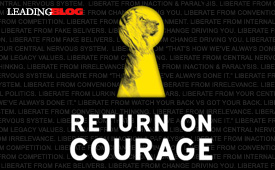 
Posted by Michael McKinney at 11:24 AM
02.02.11

Deep Factors Shaping the Global EconomyOutrageous Fortunes is a book about what in economic terms, could be. It is a provocative guide to global trends. Instead of focusing on moment–by-moment market predictions, author Daniel Altman, looks at deeper, underlying economic factors that we frequently overlook in the short-term view. Fundamentally, he states that “over long periods of time, countries with similar deep factors tend to reach similar limits of growth and prosperity.”And it is the deep factors matter the most says Altman. “They will determine whether entire generations—hundreds of millions of people—live better or worse than their predecessors. The deep factors’ origins lie in geography, climate, culture, politics, and historical accident. As a result, he speculates that China’s moment in economic history "will be impressive, but brief.” With corruption, lack of a first-rate technology infrastructure, resistance to start-up businesses, and an aging population, average incomes in China will grow at lower rates than in the U.S. He asserts that American’s will find new sources of work in their “selling power.” He isn’t ignoring the fact that we are losing jobs to the Internet or that people do sell all over the world, but his point is that American culture has made Americans uniquely suited to sell products and services over a more diverse (global) population. The primary attribute of the American way of selling, says Altman, is the ability to “transcend cultural differences by isolating the lowest common denominator.” As this is the long view, Altman says that means that there is room to maneuver. Over a period of 20 to 30 years, it is possible to make the necessary changes needed to alter our economic futures. But it will take will and political continuity. “The people and leaders need to perceive the risks, grasp the opportunities, and commit to maintaining the same posture even as the parties in power change.” This is not easy for it requires one generation sacrificing for the next and long-term political thinking that is so rare these days. To solve our global issues, “countries will have to work together.” “Yet,” he fears, “the political institutions that provide the framework for global problem-solving may not be up to the task.” He gives a couple of reasons why the gaps developing from the forces of economic integration and rapid globalization will threaten the cooperation necessary to solve our problems. “First, when people live very different lives, it becomes harder for them to understand or even be aware of one another’s problems….Second, it’s hard for two very different countries to negotiate on equal terms, even with a supposed level playing field.” The negotiations can take on a “coercive quality.” Whether his predictions come true or not, there is plenty here to think about as we look ahead. And as I’ve written before, the challenge isn’t leading a tribe, it’s leading across tribes. That requires a very different mindset and approach to people and ideas. 
Posted by Michael McKinney at 09:51 AM
02.01.11

First Look: Leadership Books for February 2011Here's a look at some of the best leadership books to be released in February.




For bulk orders call 1-800-423-8273  Build your leadership library with these specials on over 155 titles. All titles are at least 40% off the list price and are available only in limited quantities. NEW EDITIONS: Rubies in the Orchard: The POM Queen's Secrets to Marketing Just About Anything by Lynda Resnick and Francis Wilkinson is now in paperback. The excellent Fierce Leadership: A Bold Alternative to the Worst "Best" Practices of Business Today by Susan Scott is also available in paperback. Read the Leading Blog review. "“When you reread a classic, you do not see more in the book than you did before; you see more in you than there was before.” —Cliff Fadiman
Posted by Michael McKinney at 08:50 AM
|
BUILD YOUR KNOWLEDGE


How to Do Your Start-Up Right STRAIGHT TALK FOR START-UPS 
Grow Your Leadership Skills NEW AND UPCOMING LEADERSHIP BOOKS 
Leadership Minute BITE-SIZE CONCEPTS YOU CAN CHEW ON 
Classic Leadership Books BOOKS TO READ BEFORE YOU LEAD |
|